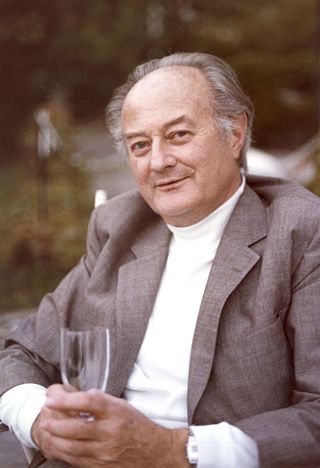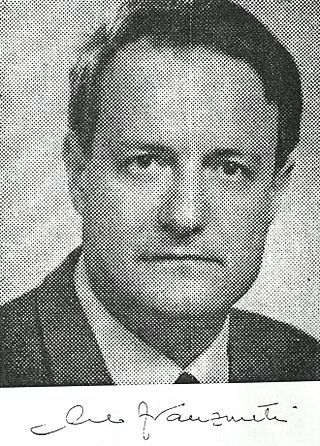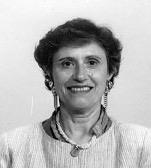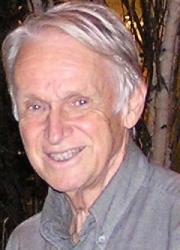Related Research Articles

The European Organization for Nuclear Research, known as CERN, is an intergovernmental organization that operates the largest particle physics laboratory in the world. Established in 1954, it is based in Meyrin, western suburb of Geneva, on the France–Switzerland border. It comprises 24 member states. Israel, admitted in 2013, is the only full member geographically out of Europe. CERN is an official United Nations General Assembly observer.

Gargamelle was a heavy liquid bubble chamber detector in operation at CERN between 1970 and 1979. It was designed to detect neutrinos and antineutrinos, which were produced with a beam from the Proton Synchrotron (PS) between 1970 and 1976, before the detector was moved to the Super Proton Synchrotron (SPS). In 1979 an irreparable crack was discovered in the bubble chamber, and the detector was decommissioned. It is currently part of the "Microcosm" exhibition at CERN, open to the public.

Paul Hermann Scherrer was a Swiss physicist. Born in St. Gallen, Switzerland, he studied at Göttingen, Germany, before becoming a lecturer there. Later, Scherrer became head of the Department of Physics at ETH Zurich.
A wire chamber or multi-wire proportional chamber is a type of proportional counter that detects charged particles and photons and can give positional information on their trajectory, by tracking the trails of gaseous ionization. The technique was an improvement over the bubble chamber particle detection method, which used photographic techniques, as it allowed high speed electronics to track the particle path.

The Joint Institute for Nuclear Research, in Dubna, Moscow Oblast, Russia, is an international research center for nuclear sciences, with 5,500 staff members including 1,200 researchers holding over 1,000 Ph.Ds from eighteen countries. Most scientists are scientists of the Russian Federation.

The Underground Area 2 (UA2) experiment was a high-energy physics experiment at the Proton-Antiproton Collider — a modification of the Super Proton Synchrotron (SPS) — at CERN. The experiment ran from 1981 until 1990, and its main objective was to discover the W and Z bosons. UA2, together with the UA1 experiment, succeeded in discovering these particles in 1983, leading to the 1984 Nobel Prize in Physics being awarded to Carlo Rubbia and Simon van der Meer. The UA2 experiment also observed the first evidence for jet production in hadron collisions in 1981, and was involved in the searches of the top quark and of supersymmetric particles. Pierre Darriulat was the spokesperson of UA2 from 1981 to 1986, followed by Luigi Di Lella from 1986 to 1990.

High-energy nuclear physics studies the behavior of nuclear matter in energy regimes typical of high-energy physics. The primary focus of this field is the study of heavy-ion collisions, as compared to lighter atoms in other particle accelerators. At sufficient collision energies, these types of collisions are theorized to produce the quark–gluon plasma. In peripheral nuclear collisions at high energies one expects to obtain information on the electromagnetic production of leptons and mesons that are not accessible in electron–positron colliders due to their much smaller luminosities.

The ISOLDE Radioactive Ion Beam Facility, is an on-line isotope separator facility located at the centre of the CERN accelerator complex on the Franco-Swiss border. Created in 1964, the ISOLDE facility started delivering radioactive ion beams (RIBs) to users in 1967. Originally located at the Synchro-Cyclotron (SC) accelerator, the facility has been upgraded several times most notably in 1992 when the whole facility was moved to be connected to CERN's ProtonSynchroton Booster (PSB). ISOLDE is currently the longest-running facility in operation at CERN, with continuous developments of the facility and its experiments keeping ISOLDE at the forefront of science with RIBs. ISOLDE benefits a wide range of physics communities with applications covering nuclear, atomic, molecular and solid-state physics, but also biophysics and astrophysics, as well as high-precision experiments looking for physics beyond the Standard Model. The facility is operated by the ISOLDE Collaboration, comprising CERN and sixteen (mostly) European countries. As of 2019, close to 1,000 experimentalists around the world are coming to ISOLDE to perform typically 50 different experiments per year.

The Proton Synchrotron is a particle accelerator at CERN. It is CERN's first synchrotron, beginning its operation in 1959. For a brief period the PS was the world's highest energy particle accelerator. It has since served as a pre-accelerator for the Intersecting Storage Rings (ISR) and the Super Proton Synchrotron (SPS), and is currently part of the Large Hadron Collider (LHC) accelerator complex. In addition to protons, PS has accelerated alpha particles, oxygen and sulfur nuclei, electrons, positrons, and antiprotons.
George Ernest Kalmus, CBE, FRS is a noted British particle physicist.

Rolf Hagedorn was a German theoretical physicist who worked at CERN. He is known for the idea that hadronic matter has a "melting point". The Hagedorn temperature is named in his honor.

Quark–gluon plasma is an interacting localized assembly of quarks and gluons at thermal and chemical (abundance) equilibrium. The word plasma signals that free color charges are allowed. In a 1987 summary, Léon Van Hove pointed out the equivalence of the three terms: quark gluon plasma, quark matter and a new state of matter. Since the temperature is above the Hagedorn temperature—and thus above the scale of light u,d-quark mass—the pressure exhibits the relativistic Stefan-Boltzmann format governed by temperature to the fourth power and many practically massless quark and gluon constituents. It can be said that QGP emerges to be the new phase of strongly interacting matter which manifests its physical properties in terms of nearly free dynamics of practically massless gluons and quarks. Both quarks and gluons must be present in conditions near chemical (yield) equilibrium with their colour charge open for a new state of matter to be referred to as QGP.

Carlo Franzinetti was an Italian experimental physicist.

Magda Galula Ericson (born 1929) is a French-Algerian physicist of Tunisian origin. Her experimental pioneering PhD work changed the understanding of critical phenomena near the Curie point and later in her career she has become known for her theoretical development of the Ericson-Ericson Lorentz-Lorenz correction.
Horst Artur Wenninger was a German physicist who spent most of his career at CERN, later for the FAIR project.
The Synchro-Cyclotron, or Synchrocyclotron (SC), built in 1957, was CERN’s first accelerator. It was in circumference and provided for CERN's first experiments in particle and nuclear physics. It accelerated particles to energies up to 600 MeV. The foundation stone of CERN was laid at the site of the Synchrocyclotron by the first Director-General of CERN, Felix Bloch. After its remarkably long 33 years of service time, the SC was decommissioned in 1990. Nowadays it accepts visitors as an exhibition area in CERN.

The 81 cm Saclay Bubble Chamber was a liquid hydrogen bubble chamber built at Saclay, in collaboration with the École Polytechnique (Orsay), to study particle physics. The team led by Bernard Gregory completed the construction of the chamber in 1960 and later it was moved to CERN and installed at the Proton Synchrotron (PS).

André Lagarrigue (1924 – 14 January 1975) was a French particle physicist. Being the initiator of the Gargamelle experiment at CERN, his work was of paramount importance in the discovery of neutral currents — the first experimental indication of the existence of the Z0 boson. This major discovery was a step towards verification of the electroweak theory, today a pillar of the Standard Model.

Emanuele Quercigh is an Italian particle physicist who works since 1964 at CERN, most known for the discovery of quark-gluon plasma (QGP). Quercigh moved as a child to Friuli with his mother and his younger brother after the early death of his father. Quercigh studied physics at the University of Milan in Italy, where he became assistant of professor Giuseppe Occhialini in 1959.

Torleif Erik Oskar Ericson is a Swedish nuclear theoretical physicist. He is known for 'Ericson fluctuations' and the 'Ericson-Ericson Lorentz-Lorenz effect'. His research has nurtured the link between nuclear and particle physics.
References
- 1 2 3 "CERN Scientific Committees | CERN Scientific Information Service (SIS)". scientific-info.cern. Retrieved 2023-08-25.
- ↑ Galison, Peter (Oct 1997). Image and Logic: A Material Culture of Microphysics. University of Chicago Press. ISBN 978-0-226-27917-6.
- ↑ Hermann, A.; Krige, J. (1987). History of CERN, II: Volume II - Building and Running the Laboratory, 1954-1965. Elsevier Science. ISBN 978-0-444-88207-3.
- ↑ Stafford, Godfrey Harry (Dec 1986). "John Bertram Adams, 24 May 1920 - 3 March 1984". Biographical Memoirs of Fellows of the Royal Society. 32: 1–34. doi:10.1098/rsbm.1986.0001. ISSN 0080-4606. S2CID 72330820.
- ↑ "Archives of Nuclear Physics Division, NP | CERN Scientific Information Service (SIS)". library.cern. Retrieved 2023-08-25.
- ↑ "ISOLDE and Neutron Time-of-Flight Experiments Committee (INTC) | Scientific Committees". committees.web.cern.ch. Retrieved 2023-08-25.
- ↑ "LHC Experiments Committee (LHCC) | Scientific Committees". committees.web.cern.ch. Retrieved 2023-08-25.
- ↑ "Research Board | Scientific Committees". committees.web.cern.ch. Retrieved 2023-08-25.
- ↑ "SPS and PS Experiments Committee (SPSC) | Scientific Committees". committees.web.cern.ch. Retrieved 2023-08-25.
- 1 2 3 4 "Structure de l'Organisation". CERN Courrier. 7 (3): 49–52. March 1967.
- 1 2 Hermann, Armin; European Organization for Nuclear Research; CERN, eds. (2000). The history of CERN. Vol. 2: Building and running the laboratory, 1954 - 1965. Vol. 2 (2. impression ed.). Amsterdam: North-Holland. ISBN 978-0-444-88207-3.
- 1 2 Krige, John (18 December 1996). History of CERN. CERN. Amsterdam Oxford: North-Holland. ISBN 978-0-444-89655-1.